Dimpled Trout Lily, Dimpled Dogtooth Violet, Southern Appalachian Trout Lily - Erythronium umbilicatum
|
Erythronium umbilicatum - Dimpled Trout Lily, Dimpled Dogtooth Violet, Southern Appalachian Trout Lily. Erythronium umbilicatum is one of 6 Erythronium species found in the eastern half of the United States (out of 24 species in North America.) It's primarily a species of the Appalachian mountains south of the Mason-Dixon line, although it is also found outside the Appalachians in southern Georgia as well as a small area of Florida, where it is listed as Endangered.
There are two subspecies of Erythronium umbilicatum - ssp. umbilicatum and ssp. monostolum. Ssp. monostolum is found only in Tennessee and North Carolina (it was also reported in 2010 as being found in Alabama), and is characterized by a single stolon (above-ground root-like structure connecting plants) per bulb connecting the plant with a "child plant". Ssp. umbilicatum is found through much of the southeastern United States; stolons are absent in this subspecies.
Found in:
AL, DC, FL, GA, KY, MD, NC, SC, TN, VA, WV
Leave comments on Erythronium umbilicatum at this link. | 
Distribution of Erythronium umbilicatum in the United States and Canada:

Map courtesy of The Biota of North America Program.
Map color key
Search Our Database: Enter any portion of the Scientific, Common Name, or both.
Do a general Google search of the entire site:
#ad
 Follow USWildflowers on Twitter
#ad
| | Site: Wolf Creek Trout Lily Preserve, Grady County, Ga Date: 2014-February-20 | Photographer: Gerald C. Williamson
Nikon D7000
Tamron SP 90MM f/2.8 AF Macro | | These are two Erythronium umbilicatum plants. As with all Erythronium species, the flowering plants of E. umbilicatum have two green leaves - the single-leaved plants do not flower. The leaves are basal, green, mottled with brown. | | 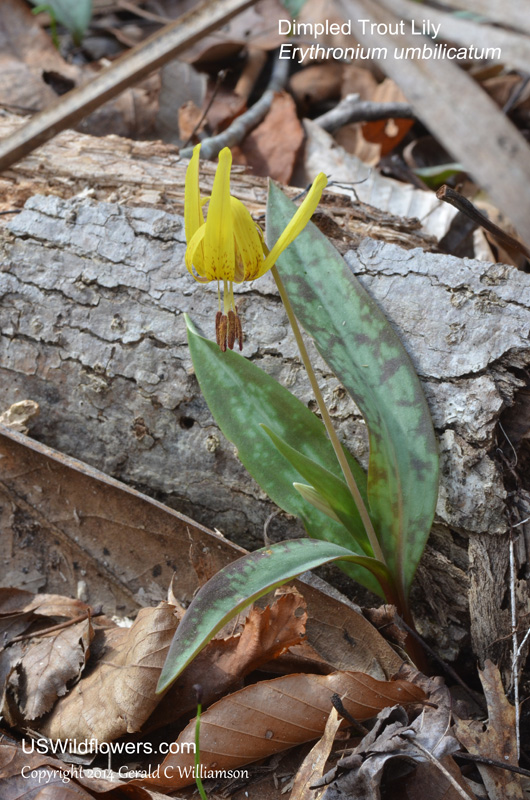
| | Site: Wolf Creek Trout Lily Preserve, Grady County, Ga Date: 2014-February-19 | Photographer: Gerald C Williamson
Nikon D7000 | | The eastern six species of Erythronium always have a single flower on the scape. Some individuals in some of the nearly 20 western species may have multiple flowers on the scape. The tepals of Erythronium umbilicatum are strongly reflexed when the flower is fully open. They are yellow, sometimes with brownish spots on the face (as here), and tinged with brownish-purple on the back. The 6 distinctive stamens may be brown, purple, or yellow. The leaves are green, mottled with brown. | | Click on the photo for a larger image
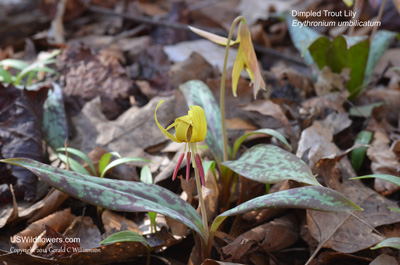
| | Site: Wolf Creek Trout Lily Preserve, Grady County, Ga Date: 2014-February-19 | Photographer: Gerald C Williamson
Nikon D7000 | | All but one (the western E. propullans) have 6 tepals. They are yellow, usually tinged with brown on the "backside" - since the flower is usually nodding at anthesis, the "backside" is normally facing up in the fully-open flowers. One of the subtle differences between E. umbilicatum and E. americanum and E. rostratum, two species which have overlapping ranges with E. umbilicatum, is that the base of the petals of E. umbilicatum lack auricles, while they are present in the other two species | | Click on the photo for a larger image
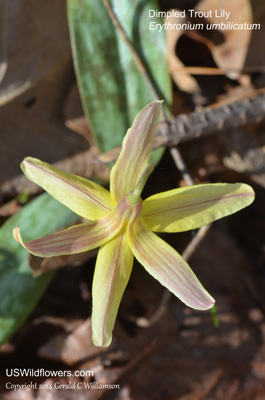
| | Site: Wolf Creek Trout Lily Preserve, Grady County, Ga Date: 2014-February-19 | Photographer: Gerald C Williamson
Nikon D7000 | | This is a colony of Erythronium umbilicatum ssp. umbilicatum, which frequently have mostly flowering, 2-leaved plants. From what I gather, ssp. monostolum has a much lower percentage of blossoming plants in a population. Both subspecies propagate through seeds, but ssp. monostolum also propagates vegetatively through their stolons. Apparently only single-leaved, immature non-flowering plants have stolons, and therefore a population of ssp. monostolum usually will have a much higher percentage of non-flowering plants than will ssp. umbilicatum. | | Click on the photo for a larger image
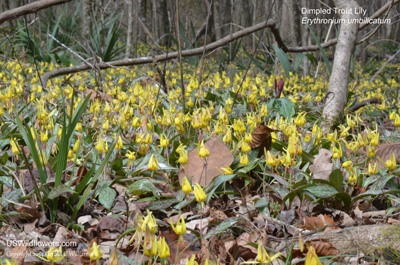
| | Site: Wolf Creek Trout Lily Preserve, Grady County, Ga Date: 2014-February-19 | Photographer: Gerald C Williamson
Nikon D7000 | | The Wolf Creek Trout Lily Preserve in south Georgia, where these photos were taken, is home to the largest known population of Erythronium umbilicatum in the world, along with many other beautiful wildflowers. | | Click on the photo for a larger image
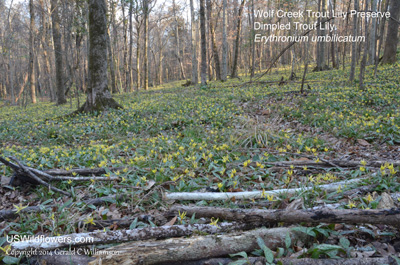
|
References used for identification and information:
|
|
| |
| #ad
|
|







